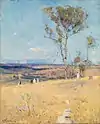Box Hill artists' camp
The Box Hill artists' camp was a site in Box Hill, Victoria, Australia favoured by a group of plein air painters in the mid to late 1880s who later became associated with the Heidelberg School art movement, also known as Australian impressionism.
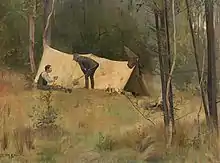
History
In the summer of 1885–86, plein air painters Tom Roberts, Frederick McCubbin and Louis Abrahams set up a tent near Damper Creek (now Gardiners Creek) on the property of David Houston, in the Box Hill area east of Melbourne.[1] They were attracted to Box Hill due to its rural scenery and tracts of untouched bushland while also being easily accessible from the city, the Box Hill railway station having opened three years prior.
Painting activities were carried out on weekends by the trio over the next few years and at various times other artists joined them, including Arthur Streeton, Charles Conder, Jane Sutherland, Tom Humphrey, John Llewellyn Jones and John Mather. By 1889, these artists had moved on from Box Hill and founded other camps around Melbourne, most notably at Heidelberg.
Notable works painted in and around the Box Hill camp include:
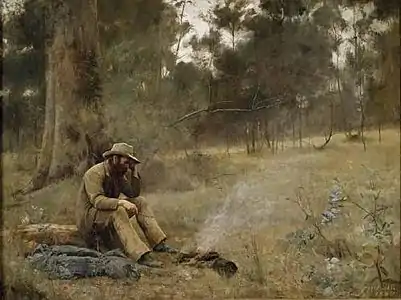
- The artists' camp (Roberts, 1886)[2]
- A summer morning tiff (Roberts, 1886) [3]
- Lost (McCubbin, 1886)[4]
- Gathering mistletoe (McCubbin, 1886][5]
- Obstruction (Sutherland, 1887)[6]
- Reconciliation (Roberts, 1887)
- Settler's Camp (Streeton, 1888)[7]
- Pastoral (Streeton, 1888)[8]
- The way to school (Humphrey, 1888)[6]
- Orchard at Box Hill (Conder, 1888)[9]
- Down on His Luck (McCubbin 1889)[10]
Legacy
The artists remembered the Box Hill era with great fondness and nostalgia. In old age, Roberts recalled:[11]
Happy Box Hill – the barked roof of the old people, Houstens [sic] – the land sylvan as it ever was – tea-tree along the creek – young blue gum-twigs – the ‘good night’ of the jackies as the soft darkness fell – then talks round the fire, the ‘Prof’ [McCubbin] philosophic – we forgot everything, but the peace of it.
The site is located within the now suburbanised area of Box Hill South and is commemorated by a cairn in Artists Park off Prince Street. Other local tributes to the camp include the Roberts McCubbin Primary School and the Whitehorse Artists' Trail.
Gallery
 Frederick McCubbin, Lost, 1886, National Gallery of Victoria
Frederick McCubbin, Lost, 1886, National Gallery of Victoria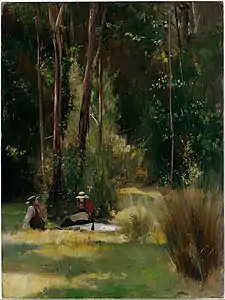 Tom Roberts, A Sunday Afternoon, 1886, National Gallery of Australia
Tom Roberts, A Sunday Afternoon, 1886, National Gallery of Australia Tom Roberts, A Summer Morning Tiff, 1886, Art Gallery of Ballarat
Tom Roberts, A Summer Morning Tiff, 1886, Art Gallery of Ballarat Tom Roberts, Evening, when the quiet east flushes faintly at the sun's last look, 1887, National Gallery of Victoria
Tom Roberts, Evening, when the quiet east flushes faintly at the sun's last look, 1887, National Gallery of Victoria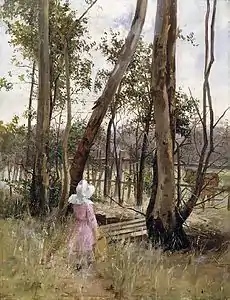 Jane Sutherland, Obstruction, Box Hill, 1887, Art Gallery of Ballarat
Jane Sutherland, Obstruction, Box Hill, 1887, Art Gallery of Ballarat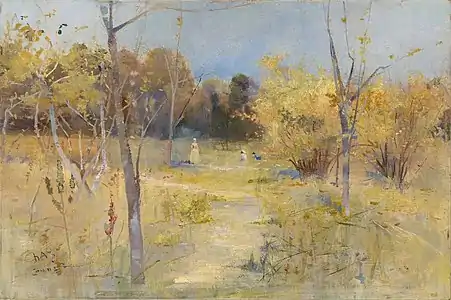 Charles Conder, Orchard at Box Hill, 1888, National Gallery of Victoria
Charles Conder, Orchard at Box Hill, 1888, National Gallery of Victoria_016_(40739962382).jpg.webp) Arthur Streeton, Butterflies and blossoms, 1889, National Gallery of Victoria
Arthur Streeton, Butterflies and blossoms, 1889, National Gallery of Victoria_037_(40739941972).jpg.webp) Arthur Streeton, Evening with bathers, 1888, National Gallery of Victoria
Arthur Streeton, Evening with bathers, 1888, National Gallery of Victoria.jpg.webp) Arthur Streeton, Settler's Camp, 1888, private collection
Arthur Streeton, Settler's Camp, 1888, private collection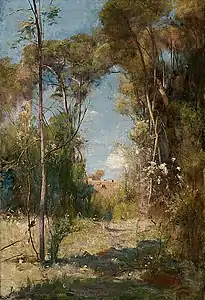 Pastoral, 1888, National Gallery of Australia
Pastoral, 1888, National Gallery of Australia
See also
- Art of Australia
- Heidelberg School
- Montsalvat
- One Summer Again, 1985 docudrama
- Heide Circle
References
- Moore, William (7 April 1985). "How Australian art was born on the road to Heidelberg". The Canberra Times (ACT : 1926 - 1995). ACT: National Library of Australia. p. 42 Section: Good Weekend. Retrieved 28 October 2013.
- "Tom Roberts - The Artist's Camp, c. 1886". In the Artist's Footsteps. Countrywide Productions. Retrieved 17 October 2008.
- "Tom Roberts - A Summer Morning Tiff, 1886". In the Artist's Footsteps. Countrywide Productions. Retrieved 17 October 2008.
- "Frederick McCubbin - Lost, 1886". In the Artist's Footsteps. Countrywide Productions. Retrieved 17 October 2008.
- "Frederick McCubbin - Gathering Mistletoe, 1886". In the Artist's Footsteps. Countrywide Productions. Retrieved 17 October 2008.
- "Jane Sutherland - Obstruction, 1886". In the Artist's Footsteps. Countrywide Productions. Retrieved 17 October 2008.
- Boland, Michaela. "Former Holmes a Court Streeton for sale after owners redecorate". The Australian. Retrieved 28 October 2013.
- "Pastoral". Collection search. National Gallery of Victoria. Retrieved 28 October 2013.
- "Charles Conder - Orchard at Box Hill (Circa 1888)". Australian collection. National Gallery of Victoria. Archived from the original on 28 July 2008. Retrieved 17 October 2008.
- "Frederick McCubbin - Down on his luck, 1889". In the Artist's Footsteps. Countrywide Productions. Retrieved 17 October 2008.
- https://www.ngv.vic.gov.au/australianimpressionism/education/insights_ssites.html Significant sites], NGV. Retrieved 15 October 2020.
